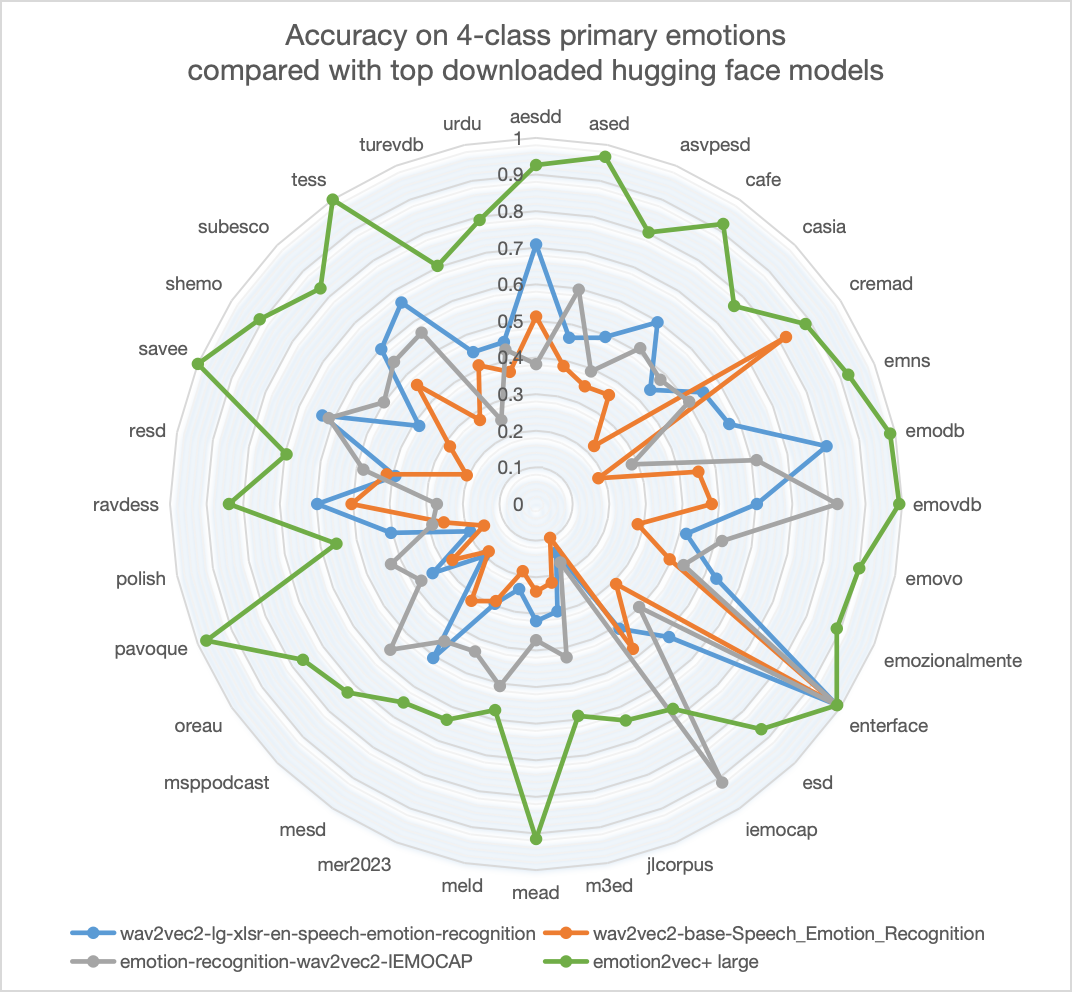EMOTION2VEC+
emotion2vec+: speech emotion recognition foundation model
emotion2vec+ large model

Guides
emotion2vec+ is a series of foundational models for speech emotion recognition (SER). We aim to train a "whisper" in the field of speech emotion recognition, overcoming the effects of language and recording environments through data-driven methods to achieve universal, robust emotion recognition capabilities. The performance of emotion2vec+ significantly exceeds other highly downloaded open-source models on Hugging Face.
This version (emotion2vec_plus_large) uses a large-scale pseudo-labeled data for finetuning to obtain a large size model (~300M), and currently supports the following categories: 0: angry 1: disgusted 2: fearful 3: happy 4: neutral 5: other 6: sad 7: surprised 8: unknown
Model Card
GitHub Repo: emotion2vec
| Model | ⭐Model Scope | 🤗Hugging Face | Fine-tuning Data (Hours) |
|---|---|---|---|
| emotion2vec | Link | Link | / |
| emotion2vec+ seed | Link | Link | 201 |
| emotion2vec+ base | Link | Link | 4788 |
| emotion2vec+ large | Link | Link | 42526 |
Data Iteration
We offer 3 versions of emotion2vec+, each derived from the data of its predecessor. If you need a model focusing on spech emotion representation, refer to emotion2vec: universal speech emotion representation model.
- emotion2vec+ seed: Fine-tuned with academic speech emotion data from EmoBox
- emotion2vec+ base: Fine-tuned with filtered large-scale pseudo-labeled data to obtain the base size model (~90M)
- emotion2vec+ large: Fine-tuned with filtered large-scale pseudo-labeled data to obtain the large size model (~300M)
The iteration process is illustrated below, culminating in the training of the emotion2vec+ large model with 40k out of 160k hours of speech emotion data. Details of data engineering will be announced later.
Installation
pip install -U funasr modelscope
Usage
input: 16k Hz speech recording
granularity:
- "utterance": Extract features from the entire utterance
- "frame": Extract frame-level features (50 Hz)
extract_embedding: Whether to extract features; set to False if using only the classification model
Inference based on ModelScope
from modelscope.pipelines import pipeline
from modelscope.utils.constant import Tasks
inference_pipeline = pipeline(
task=Tasks.emotion_recognition,
model="iic/emotion2vec_plus_large")
rec_result = inference_pipeline('https://isv-data.oss-cn-hangzhou.aliyuncs.com/ics/MaaS/ASR/test_audio/asr_example_zh.wav', granularity="utterance", extract_embedding=False)
print(rec_result)
Inference based on FunASR
from funasr import AutoModel
model = AutoModel(model="iic/emotion2vec_plus_large")
wav_file = f"{model.model_path}/example/test.wav"
res = model.generate(wav_file, output_dir="./outputs", granularity="utterance", extract_embedding=False)
print(res)
Note: The model will automatically download.
Supports input file list, wav.scp (Kaldi style):
wav_name1 wav_path1.wav
wav_name2 wav_path2.wav
...
Outputs are emotion representation, saved in the output_dir in numpy format (can be loaded with np.load())
Note
This repository is the Huggingface version of emotion2vec, with identical model parameters as the original model and Model Scope version.
Original repository: https://github.com/ddlBoJack/emotion2vec
Model Scope repository: https://www.modelscope.cn/models/iic/emotion2vec_plus_large/summary
Hugging Face repository: https://huggingface.co/emotion2vec
FunASR repository: https://github.com/alibaba-damo-academy/FunASR
Citation
@article{ma2023emotion2vec,
title={emotion2vec: Self-Supervised Pre-Training for Speech Emotion Representation},
author={Ma, Ziyang and Zheng, Zhisheng and Ye, Jiaxin and Li, Jinchao and Gao, Zhifu and Zhang, Shiliang and Chen, Xie},
journal={arXiv preprint arXiv:2312.15185},
year={2023}
}
- Downloads last month
- 499
